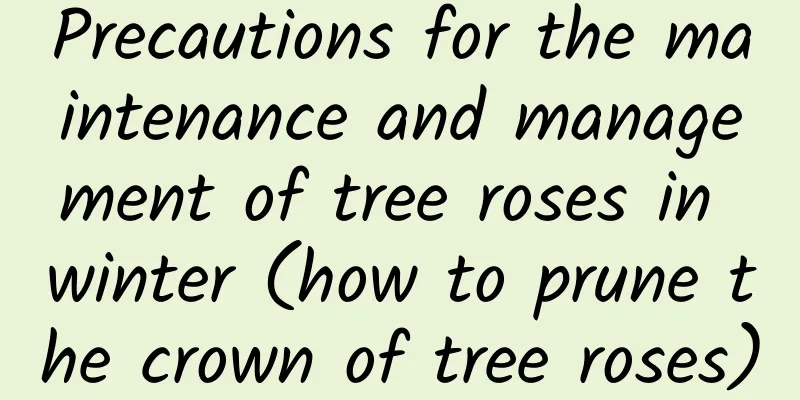Precautions for the maintenance and management of tree roses in winter (how to prune the crown of tree roses)

1. Winter management of tree rosesWinter management of tree roses is usually divided into three steps: pruning and shaping, winter fertilizer application, and cold protection and warmth preservation. 1. Pruning and shapingWinter pruning is a must for woody flowers. It not only removes pests and diseases and adjusts the distribution of branches, but also stores nutrients and beautifies the crown. Therefore, it is the most important pruning of the year. When pruning, you can shape it according to the situation, or you can slowly prune and create it according to the ideal shape. (1) Disease prevention pruning Adult tree roses go through a year of growth, bud formation, and flowering, and are also affected by some special climate and environment, so they will inevitably breed pathogens or become hosts for insect eggs. Therefore, after winter begins, when all the yellow leaves have faded, it is advisable to first cut off the diseased and weak branches and dry branches to reduce future troubles. (2) Lighting and pruning Adult rose trees often have densely distributed branches because they focus on building their crowns, and the rose itself has a strong ability to branch and grow. Therefore, during winter pruning, it is advisable to thin out the dense, crossed and overlapping branches as much as possible to sparse the branches in the crown to provide space for the growth of new branches in the next year. At the same time, it is convenient for lighting and ventilation. (3) Modeling and pruning The beauty of the tree lies in its unique shape. Not only is the trunk of the tree standing tall and independent, but the crown is also unique and the flowers are flourishing, forming a unique landscape. For example, the ordinary spherical shape; the unique fan shape; the vivid flying bird shape; the cascading waterfall shape, etc. As long as you have unique artistic cells and rich imagination, you can release them during this winter pruning. Therefore, when pruning in winter, you can pull the branches where necessary, cut back where necessary, or slow down where necessary according to the ideal shape, so as to make the tree crown bloom beautifully and have a unique shape. 2. Winter fertilizer applicationThere is a saying that goes, "Big trees have deep roots." Because tree roses have gone through the process of root and trunk cultivation, their root systems are more developed, their trunks are thicker, and their crowns are larger, so their demand for fertilizers will naturally be much greater. Therefore, during the winter dormancy period, well-rotted farmyard manure should be applied in time to store sufficient nutrients for the next year. 3. Keep warmAlthough the appearance of tree roses has changed slightly, they still have the characteristics of cold and drought resistance of general roses. In the south, even if they are planted in the open field, they can usually survive the winter safely, but in the north, due to the low temperature, some appropriate cold-proof and warm-keeping measures must be taken, such as using the cover method, the shielding method, the whitewashing method, etc. 2. Precautions for winter maintenance of tree roses① Pay attention to the choice of pruning time When pruning tree roses in winter, special attention should be paid to the specific pruning time. Generally, the best time is late autumn or early winter after the leaves fall, or late winter or early spring, and it is best to prune on consecutive sunny days. ②Pay attention to the disinfection and maintenance of the trimmed mouth Due to the need for shaping, tree roses often have thick branches cut short or retracted during winter pruning, which results in a larger affected area, slower healing, or infection and rot. Therefore, after pruning, it is advisable to disinfect the affected area in time and apply protective materials to prevent the wound from infection and heal quickly. ③ Pay attention to the removal of branches, dead branches, leaves and weeds After pruning the trees, be sure to thoroughly clean up and burn the pruned branches, fallen leaves, dead branches and withered grass . Because these dead branches and leaves often carry germs and insect eggs, if they are not removed in time, they may leave hidden dangers. Therefore, it is advisable to burn them to keep the garden clean and tidy. ④Avoid frequent watering After the tree enters the dormant period in winter, it has very little demand for water and nutrients, so it is better to water it less or not at all. Generally, it is better to keep it moist and dry, and it is better to pinch it loose. Avoid frequent watering to avoid root closure or frost damage. 1 |
Recommend
The difference between purple-backed amaranth and blood-skinned vegetable
1. Leaf Difference The leaves of purple-backed gy...
What flowers are suitable for growing in Shannan? What are the city flowers and trees?
1. Climate characteristics of Shannan Shannan'...
The fastest way to root chrysanthemum cuttings
Chrysanthemum cutting time Chrysanthemum cuttings...
Is gold more suitable for yin or yang?
Is gold more suitable for yin or yang? Golden Hun...
Common diseases and pests of Axe-leaved Peperomia and their control methods
Common diseases and pests of Axeleaf Peperomia Di...
How to plant the walnut?
1. Soil environment The walnut loves sunlight ver...
Dracaena cultivation methods and precautions
Dracaena is highly favored for its dignified shap...
What is the best way to treat yellowing lucky bamboo leaves?
With its elegant posture and evergreen leaves, lu...
How to care for lisianthus before and after flowering
Care of lisianthus before flowering The flowers o...
Is the Venus flytrap poisonous? Can I keep it at home?
1. Is it poisonous? It is not poisonous. It relie...
Can the fruits of the osmanthus tree be eaten?
Can bear fruit Osmanthus can bloom and bear fruit...
Holly cultivation methods and precautions
1. Soil During the breeding period, it is necessa...
How long is the growth cycle of shepherd's purse?
Introduction to Shepherd's Purse Growth Sheph...
How to plant peach pits to germinate
1. Preparation before sowing Select peach pits wi...
Decorating a balcony? Did you know that these vines are particularly suitable?
Balcony Queen Clematis. To be worthy of this titl...









